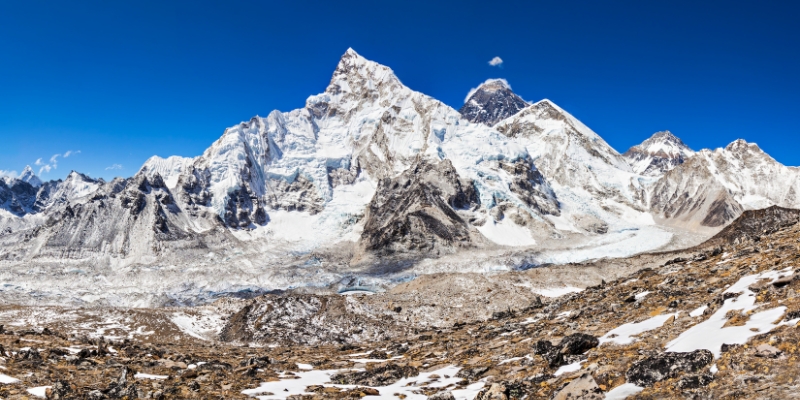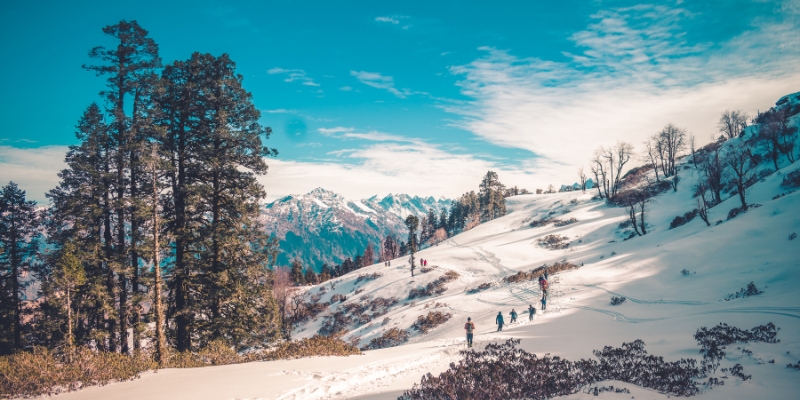Advertisement
Winter hiking in the Himalayas is a thrilling way to avoid the throng and view this renowned mountain range in a fresh light. Winter turns the Himalayas into a peaceful, snow-covered beauty, despite its stunning scenery and hard journeys. Winter climbs in the Himalayas are tough but rewarding due to cool mountain air, stunning snowy panoramas, and serenity.
Winter hikes allow you to observe old routes in a new light. Trekkers are captivated by snow-covered trails, frozen lakes, and shimmering summits. This season is great for people seeking tranquility in the Himalayas due to its low numbers and closer connection to nature. However, sub-zero temperatures, snowy paths, and the need for specific clothing make winter hiking difficult. A safe and pleasurable Himalayan winter hike requires planning, terrain awareness, and mountain respect.

Kuari Pass Trek:
The Kuari Pass trip in Garhwal, Indian Himalayas, is a winter paradise of snow-clad mountains. Trekkers may see Nanda Devi, Dronagiri, and Kamet from pathways through oak and rhododendron woods on this hike. Winter's snow-capped trees and glistening meadows make the Kuari Pass trip special. Walk through this untouched wilderness and feel like you're in a fairy tale.
Beginners may climb Kuari Pass, although winter preparation is necessary. The path is steep and difficult in snow and ice. Insulated clothes, hiking boots, and walking poles are essential during winter. Winter Garhwal Himalaya trekking involves meticulous preparation, including weather predictions and temperature reductions. However, the breathtaking views, peaceful atmosphere, and feeling of achievement from crossing this pass make it a walk you'll never forget.
Chandrashila Trek:
Winter travelers seeking Himalayan beauty choose the Chandrashila trip, which starts in Chopta. This walk is especially appealing in winter since you may visit Tungnath Temple, one of the world's tallest Shiva temples. Ascending through snow-covered rhododendron and oak woodlands is wonderful. After the walk, Chandrashila Summit offers a beautiful panorama of the Garhwal Himalayas, including Chaukhamba, Kedar Dome, and Nanda Devi.
Winter Chandrashila hikers may expect chilly and ice conditions. Crampons and hiking poles are recommended for the treacherous path. Planning your journey for dawn lets you see the mountains painted in gold, a stunning sight. Winter Chandrashila treks provide beautiful views and a spiritual connection as you visit the old temple and enjoy the snowy Himalayas.
Har Ki Dun Trek:
Winter makes the Har Ki Dun trek in the Garhwal Himalayas a tranquil and beautiful experience. Its lush slopes and deep woods are famous in summer, but in winter, they become a winter paradise. Snow-capped peaks surround the Har Ki Dun valley, providing a surreal backdrop. Trekkers will traverse freezing streams, cross snow-covered paths, and see frozen waterfalls.
Warm clothes and waterproof footwear are needed for Har Ki Dun winter hiking. Be prepared for chilly weather since temperatures might drop substantially. Braving the cold weather lets you appreciate the valley without the throng. The Har Ki Dun winter trek's remoteness in the snow-covered wilderness and pure splendor will leave you in awe of the Himalayas' winter charm.
Kedarkantha Trek:
Kedarkantha is a popular Himalayan winter trip with beautiful vistas of snow-covered peaks and valleys. This scenic trip from Sankri through pine trees and beautiful villages is intriguing. Seeing a frozen lake in winter makes Kedarkantha remarkable. Swargarohini, Bandarpoonch, and Black Peak are best seen from the snow-covered Kedarkantha base camp.
Winter hikers on the Kedarkantha path may expect sub-zero temperatures and heavy precipitation. Gaiters, snow boots, and thick layers are required for the arduous trip, particularly in heavy snow. To climb Kedarkantha's top and enjoy the Himalayas' winter grandeur is a memorable experience for all explorers.

Rupin Pass Trek:
The Rupin Pass trip is a thrilling winter experience over the Himalayas' most varied scenery. This journey begins in Dhaula, Uttarakhand, and has snow-covered woods, lovely villages, and spectacular Rupin River vistas. Winter Rupin Pass treks are difficult, traversing frozen streams and climbing high snow-covered terrain. The reward is seeing the snow-capped Dhauladhar and Kinnaur peaks.
Winter hikers should have expertise and have ice axes, crampons, and insulated clothing for the Rupin Pass trip. The trip is difficult, but climbing the pass and seeing the Himalayas in winter is unforgettable. A spirit of adventure and proper preparation make the Rupin Pass hike an exciting winter experience.
Brahmatal Trek in Winter:
In winter, the Brahmatal Trek in Garhwal, Uttarakhand, India, becomes a snow paradise. This magnificent walk takes you through lush woods, frozen lakes, and picturesque Himalayan peaks.
Brahmatal Trek becomes a snowy wonderland in winter, drawing explorers seeking seclusion and Himalayan grandeur. This trek's highlight is the magnificent Brahmatal Lake, which freezes over in winter and is situated among snow-capped hills.
Trekking along snow-covered slopes and camping in Brahmatal's remoteness gives hikers unforgettable Himalayan winter experiences. For high-altitude winter trekkers in India, the tranquility, unbroken vistas of snow-covered peaks, and struggle of icy trails make this walk unforgettable. The Brahmatal Trek is an exciting winter adventure in the Himalayas for seasoned trekkers and novices alike.
Chadar Trek:
The Chadar Trek via the icy Zanskar River in Ladakh, India, is an exciting adventure. In the native language, "Chadar" means "blanket" and describes the thick sheet of ice that covers the river in winter. This natural occurrence makes the river a dreamlike walking trail like no other.
The icy Zanskar River trek is unearthly. As the river freezes and thaws, the walking path varies year, giving it a varied trip. Ice forms like beautiful icicles and majestic frozen waterfalls decorate the frozen river, transforming the environment. The Chadar Trek also lets you see the Zanskari tribe who trade on this frozen river in winter. Immerse yourself in local culture and see the Ladakhi people's extraordinary perseverance in harsh winter circumstances.
Goechala Trek:
The popular Goechala Trek in Sikkim, India, in Kanchenjunga National Park is even more beautiful in winter. This hike is famous for its vistas of Mount Kanchenjunga, the world's third-highest peak. The winter Goechala Trek is a unique experience as the terrain becomes a peaceful snow paradise.
The walk in winter is beautiful with snow-covered paths, frozen lakes, and Mount Kanchenjunga. The lush green trees and colorful rhododendron-covered slopes of spring and summer are now draped in peaceful white. The winter Goechala adventure provides a peaceful Himalayan adventure.
Conclusion:
Winter hikes in the Himalayas give a unique chance to see snow-covered vistas and the isolation of the mountains, but they also demand meticulous planning and preparation. Winter trekkers must be physically fit, have the right clothing, and know the terrain and weather.
Each winter trek—Kuari Pass, Chandrashila, Har Ki Dun, Kedarkantha, and Rupin Pass—has its own appeal and adventure. These excursions provide lifelong memories of ice lakes and snowy summits. Snow-clad Himalayas invite travellers to explore their breathtaking landscapes and experience winter hiking in one of the world's most famous mountain ranges.
Advertisement

Sikkim's Top Trekking Destinations

Europe's Attractions to Visit That Won't Break the Bank

Top Places to Visit Near Darjeeling: An Ultimate Guide

The Transformative Power of Travel on Your Personality and Health

Adventure Apps: Enhance Your Travel Safety

Igloo Stay In Manali 2023: An Ultimate Guide

Exploring The City Of a Hundred Spires: A Four-Day Guide To Prague

Ireland’s Ocean Giant Captured in TikTok: The Basking Shark Phenomenon

Exploring Saigon Central Post Office

Top 8 Winter Treks in the Himalayas: A Snowy Adventure Guide

The Best Resorts in God’s Own Country, Kerala
